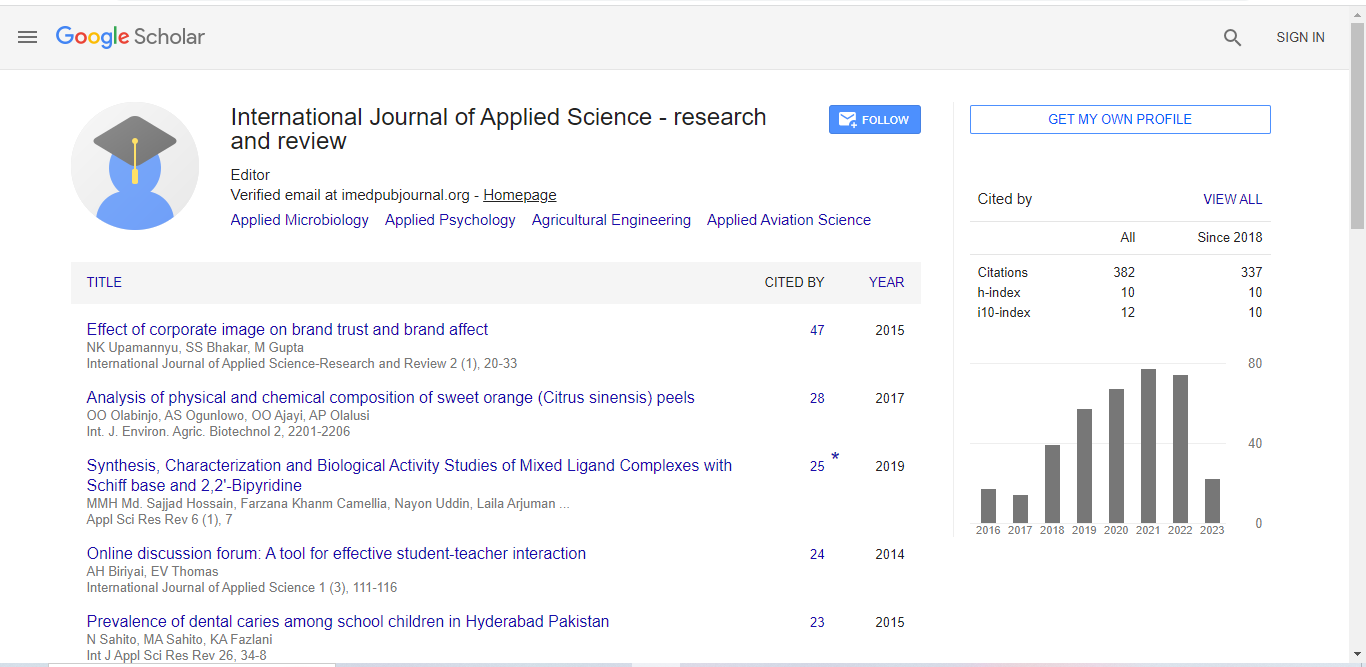Short Communication - (2024) Volume 11, Issue 5
Single-Shot Spatiotemporal Characterization of Ultrafast Lasers Using Spectral Interferometry with Fiber Array
Oliver Morgan*
Department of Applied Science, University of Patras, Greece
*Correspondence:
Oliver Morgan,
Department of Applied Science, University of Patras,
Greece,
Email:
Received: 01-Oct-2024, Manuscript No. IPIAS-24-21951;
Editor assigned: 03-Oct-2024, Pre QC No. IPIAS-24-21951 (PQ);
Reviewed: 17-Oct-2024, QC No. IPIAS-24-21951;
Revised: 22-Oct-2024, Manuscript No. IPIAS-24-21951 (R);
Published:
29-Oct-2024, DOI: 10.36648/2394-9988-11.5.50
Introduction
The precise measurement and characterization of ultrashort
laser pulses is a critical task in many fields of science and
technology, from ultrafast optics and spectroscopy to quantum
information processing and material science. Traditional
methods of characterizing such pulses often involve timeconsuming
processes, multiple measurements, or the need for
synchronization between various components. However, recent
advancements have led to more efficient and faster techniques
for capturing the spatiotemporal properties of these pulses in a
single shot. One promising technique is spectral interferometry,
particularly when used in conjunction with a fiber array, which
offers a way to characterize ultrashort laser pulses in both space
and time with high resolution.
Description
Spectral interferometry is based on the interference between
two light fields that have been spectrally separated, typically
involving the use of a reference pulse and the pulse under
investigation. When combined with an array of optical fibers,
this technique can measure both the temporal and spatial
characteristics of ultrashort laser pulses simultaneously, allowing
for a comprehensive analysis of the laser’s properties. In such a
system, the fiber array serves as a spatial light modulator that
captures the light at multiple positions across the beam profile,
enabling spatially resolved measurements. This is particularly
useful in characterizing the spatial-temporal dynamics of pulses,
where the intensity, phase, and duration of the pulse can vary
across different spatial locations within the beam. The principle of
spectral interferometry with fiber arrays relies on the interaction
between a reference pulse and the pulse to be measured. The
reference pulse, which is typically generated from the same laser
system or from a separate femtosecond pulse source, undergoes a
controlled delay and then interferes with the unknown pulse. The
resulting interference pattern contains both spectral and temporal
information, which can be used to reconstruct the original pulse
properties. By introducing a fiber array, each fiber captures a small
portion of the light field at a specific position in the beam. These
fiber elements provide spatially resolved spectral interference
signals that can be analyzed in parallel. This allows for a singleshot
measurement of both the temporal evolution and spatial
distribution of the ultrashort pulse, significantly improving the
speed and efficiency of the characterization process. One of the
key advantages of using a fiber array in spectral interferometry is
its ability to record data from multiple spatial points across the
pulse simultaneously. This multiplexing capability enables the
capture of spatial variations in the temporal characteristics of the
pulse, which is especially important in the study of ultrafast pulses
that may have complex spatiotemporal profiles. For instance, an
ultrashort laser pulse may exhibit varying durations, chirps, or
phase shifts depending on the position within the beam, and a
fiber array allows these variations to be captured without the need
for moving components or separate measurements. The ability
to perform single-shot, spatially resolved measurements is also
beneficial when dealing with highly sensitive systems where the
pulse can change rapidly or is difficult to replicate. Additionally,
the fiber array provides high spatial resolution, enabling detailed
analysis of the laser pulse’s spatial profile. By sampling the pulse
at different positions across its transverse profile, the system can
capture any spatial distortions, such as wave-front aberrations or
intensity inhomogeneities, that may be present. These distortions
could impact the pulse’s focusing properties or its interaction
with materials, making it important to characterize the beam’s
spatial characteristics accurately. The fiber array technique can
also be applied to study femtosecond pulses that are temporally
compressed or stretched, providing information about pulse
shaping, modulation, and how the pulse evolves over time. Another significant advantage of spectral interferometry with
fiber arrays is its applicability to single-shot measurements. Many
ultrafast laser systems, particularly those used in high-energy
physics or nonlinear optics, generate pulses that are difficult or
impossible to reproduce exactly [1-4].
Conclusion
In conclusion, spectral interferometry with fiber arrays offers
a powerful and efficient method for the spatiotemporal
characterization of ultrashort laser pulses. By leveraging the ability
to measure both spatial and temporal properties in a single shot,
this technique overcomes many of the limitations of traditional
methods, providing high-resolution, multiplexed measurements
that are essential for understanding and optimizing ultrafast
laser systems. Its wide applicability to diverse fields makes it an
indispensable tool for researchers working with complex ultrafast
laser sources, enabling more precise control and analysis of laser
pulse characteristics in real-time.
Acknowledgement
None.
Conflict Of Interest
The author declares there is no conflict of interest in publishing
this article.
References
- Pickova D, Ostry V, Toman J, Malir F (2021) Aflatoxins: History, significant milestones, recent data on their toxicity and ways to mitigation. Toxins 13: 399.
[Crossref] [Google Scholar]
- Kanu AB (2021) Recent developments in sample preparation techniques combined with high-performance liquid chromatography: A Critical review. J Chromatogr A 1654: 462444.
[Crossref] [Google Scholar]
- Piehler J, Brecht A, Geckeler KE, Gauglitz G (1996) Surface modification for direct immunoprobes. Biosens Bioelectron 11(6-7): 579-90.
[Crossref] [Google Scholar]
- Zucca P, Sanjust E (2014) Inorganic materials as supports for covalent enzyme immobilization: methods and mechanisms. Molecules 19: 14139-14194.
[Crossref] [Google Scholar]
Citation: Morgan O (2024) Single-shot Spatiotemporal Characterization of Ultrafast Lasers Using Spectral Interferometry with Fiber Array. Int J Appl Sci Res Rev. 11:50.
Copyright: © 2024 Morgan O. This is an open-access article distributed under the terms of the Creative Commons Attribution License, which permits unrestricted use, distribution, and reproduction in any medium, provided the original author and source are credited.

